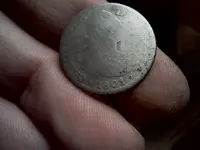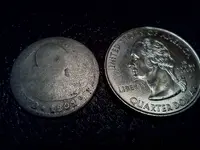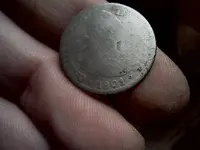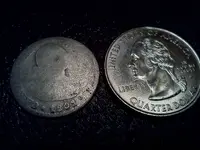Re: Is it unusual ? 1801 1 Reale only 4"
The generally accepted theory is that sink rates are determined by the difference in the density of the soil and the density of the sinking object (treasure). The density is measured in g/cm3.
Looser soils and soils higher in organic content are less dense, averaging 1.33 g/cm3 for a medium texture soil with ~ 50% pore space. Reference
http://soils.usda.gov/sqi/assessment/files/bulk_density_sq_physical_indicator_sheet.pdf.
Metals have a much higher density. Some of the more common are listed below with their density in g/cm3. Reference
http://www.matpack.de/Info/Nuclear/Elements/density.html:
Aluminium 2.70
Iron 7.87
Nickel 8.91
Copper 8.92
Zinc 7.14
Silver 10.49
Tin 7.29
Platinum 21.45
Gold 19.32
Lead 11.34
Generally speaking, the maximum theoretical sink depth can be easily determined. The denser metals will continue to sink until the soil density matches the density of the metal. Depending on the soil composition, this could easily be out of the reach of typical handheld metal detectors.
The sink rate can't be determined so easily, as there are many influencing factors. Some of the stronger influences on sink rate are soil porosity, soil particulate size, rainfall, drainage, object density, orientation, surface area, and object shape. I’ll briefly discuss how each influences sink rate.
The porosity of the soil is a strong contributor to the sink rate (porosity describes the amount of empty space in the soil). In order for the coin to move past the soil impeding it, the soil has to be displaced. The more porous the soil, the more easily soil can be displaced, by filling the empty pockets (pores) in the soil. Soil particulate size is another aspect that influences sink rate. Larger particulates will have a higher density, and will generally be more difficult to displace, as they require larger pores to accept them, and more force to displace them. Having said that, rainfall is probably the strongest contributor to the sink rate, especially in porous souls. During heavy rainfalls, or poor drainage in lighter rainfalls, soil can actually become suspended in the water, allowing it to be more easily displaced by denser objects. Quicksand is a good example of soil suspended in water, although quicksand is an extreme example.
Overall weight, or density, is a major factor in sink rate, but density can be offset by orientation, and surface area. The more surface area that is directly impeded by soil (directly below the object, along its sink path), the more soil will need to be displaced to allow the object to sink. Coins on edge will typically sink faster than coins on their side because less soil needs to be displaced to allow the coin to sink. Items with greater surface areas will generally sink slower, so a silver broach, for example, would sink slower than a gold coin of the same weight, assuming both were oriented the same. The shape of an object also affects sink rate, in the same manner that surface area affects it. Spherical or cylindrical objects, like bullets, are better at displacing soil than say, a button. Bullets were designed to reduce friction, and that same design also allows them to displace soil better. Irregularly shaped objects will generally sink slower, depending on orientation.
Even without taking sink rate into account, there are various other factors that can either increase of decrease the amount of soil covering the object. Silting, organic decay & deposit, wind & water erosion, floods, construction, natural disasters, and many other factors can play a role. Living in the new 'tornado alley', I can tell you that objects can easily be dug up and deposited elsewhere by a tornado.
Sorry for the long-winded response. The short answer is, 'just be happy you found it'.






















